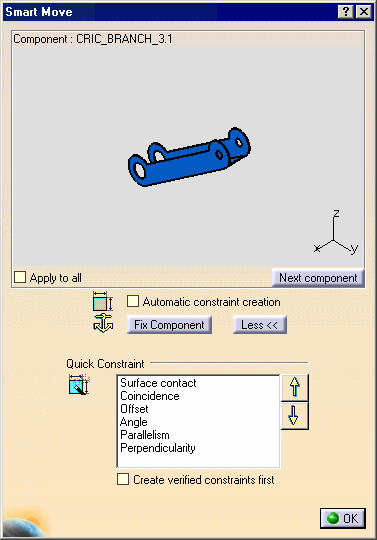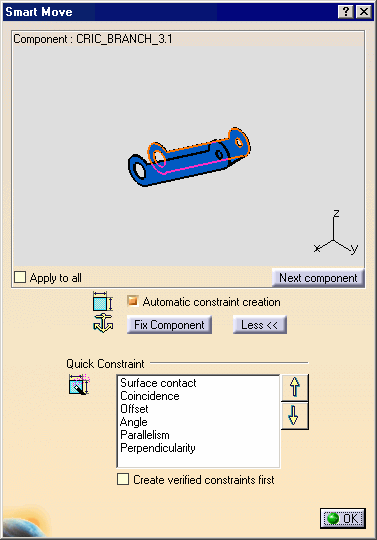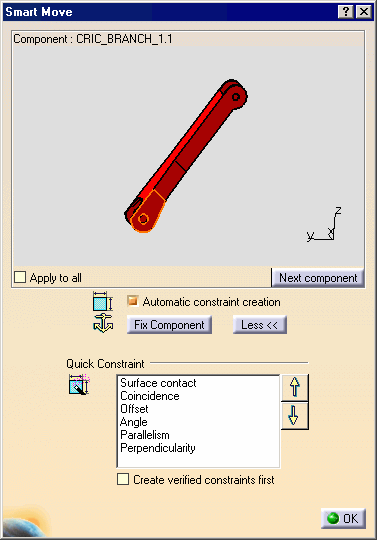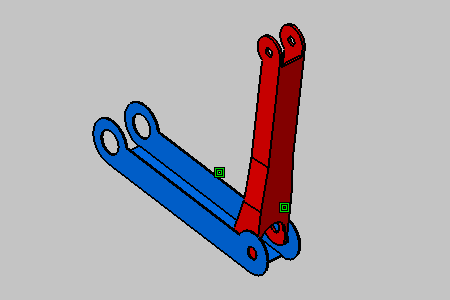- The Smart Move combines simple snap and double snap, see the Assembly Snaps reference to know more about the simple snap and double snap capabilities.
-
Following are the rules, which apply a simple snap or a double snap in Smart Move
are the following:
- The first time you launch the Smart Move or each time that you are selecting a first component different than the first in the previous Smart Move, a double snap is made.
- Each time that you are selecting the same first component as the first in the previous Smart Move, a simple snap is made.
- Select the affected components and run the Smart Move
display the smart move with viewer, otherwise run the Smart Move
and select the geometrical elements display the simple smart move,
compare with Smart Move.
The Smart Move previews in the Viewer frame only the pre-selected components affected to make the smart move.
Using the viewer allows you to select with more accuracy the geometrical element to be moved and constrained. In the viewer window you can move and rotate the component regardless of its position the geometry window. The viewer do not forbid the selection of the geometrical element in the geometry window. - The Smart Move is able to work in visualization mode, which means the positioned component and the positioning parts are no longer need to be switched into design mode. However, in order to create constraints, you must be working in Design mode.
- The Smart Move is disabled when the Automatic switch to Design mode is off and related components of the Active component in Visualization mode.
-
Select CRIC_BRANCH_1 and CRIC_BRANCH_3 in the specification tree.
-
The Viewer frame: this window appears only if you pre-select the components affected to perform the smart move. These components must belong to the same parent component.
Using the viewer allows you to select with more accuracy the geometrical element to be moved and constrained. In the viewer window you can move and rotate the component regardless of its position the geometry window. The viewer do not forbid the selection of the geometrical element in the geometry window. -
The Automatic constraint creation option allows you to create constraints to keep the move operation.
-
The Fix Component command allows you to prevent the current component from moving from its parents during the update operation. See Fixing a Component.
-
The Quick Constraint frame contains the list of the constraints that can be set. This list displays these constraints in a hierarchical order and can be edited by using both arrows to right of the dialog box.

-
Select the Automatic constraint creation option.
The application creates the first possible constraint as specified in the list of constraints having priority. For more about this list, please refer to Quick Constraint.
For automatic constraint creation, the only difference from behavior of Quick Constraint is that simple shapes like point, plane, line and axis system are only considered for this command. Although, the user can select the cylinder, cone and Sphere (using Other Selection from contextual menu), internally these are treated as the simple shapes.
-
Select the face of CRIC_BRANCH_3 as shown in the dialog box.

-
Click Next component.
-
Select the face of CRIC_BRANCH_1 as shown in the dialog box.

The contact constraint is created.

-
Click OK to confirm and quit the command.